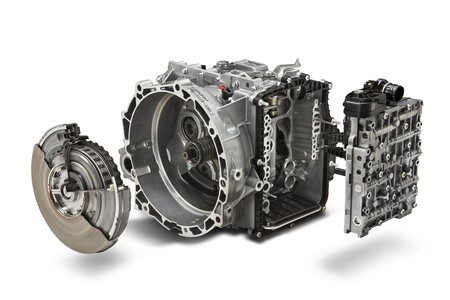
The unfortunate reality for Chrysler in North America is that aside from the new Ram, the Wrangler and the minivans, few of its products are considered desirable alternatives in their segments. At least part of that is due to what many consider - rightly or wrongly - to be outdated powertrains. That impression certainly won't be helped by this latest release from Chrysler. When the Dodge Journey was launched in the European market this summer, it was offered with both a 2.0L turbodiesel engine and an optional 6-speed Getrag dual clutch transmission. Here in the home market we only have the option of four and six cylinder gas engines with automatic transmissions that have four and six ratios respectively.
To make matters worse, the Sebring and Avenger which were already available overseas with the diesel engine now also offer the dual clutch gearbox. The DCT uses a pair of wet clutches that are coupled to alternating ratios, one handling 1,3, 5 and the other taking care of 2,4 and 6. The electronic controls offer quick, seamless automatic shifting and a six percent reduction in fuel consumption than the four speed automatic. Over here we're going to have to wait until 2010 to get DCT's in Chryslers to go along with the new Phoenix engines. I'm generally a manual transmission kind of guy, but my experience with VW's DSG has convinced me that DCTs can be OK. How come the Europeans get so much of the good stuff first?
[Source: Chrysler]
Chrysler LLC Expands Use of Fuel-saving Dual-clutch Transmission Technology
* Dodge Avenger and Chrysler Sebring are the latest vehicles available in markets outside North America with Chrysler's new dual-clutch transmission
* Achieves fuel economy improvement and CO2 emission reduction of 6 percent
* Offers consumers smooth acceleration
* Chrysler's new dual-clutch transmission debuted this summer in markets outside North America with the launch of the all-new Dodge Journey
Auburn Hills, Mich., Sep 25, 2008 - Chrysler LLC is expanding the number of vehicles equipped with its new fuel-saving dual-clutch transmission in markets outside North America. In addition to the all-new Dodge Journey, which launched this summer, the Dodge Avenger and Chrysler Sebring, powered by the 2.0-liter turbo-diesel engine, will now also be available with this new technology. Chrysler's new dual-clutch transmission-developed in partnership with Getrag-will provide consumers a fuel economy improvement and CO2 emission reduction of 6 percent compared to a traditional four-speed automatic transmission.
"Chrysler's new dual-clutch transmission is the next step in transmission technology, offering consumers improved fuel economy along with smooth shifting," said Frank Klegon, Executive Vice President – Product Development, Chrysler LLC. "This important new Chrysler technology is one of several initiatives we have in place to directly focus on improving fuel efficiency across our vehicle lineup."
Chrysler's commitment to dual-clutch transmission technology is part of the Company's powertrain offensive, announced last year.
Dual-clutch Transmission Technology
Chrysler's dual-clutch transmission technology improves fuel economy and CO2 emissions by reducing parasitic losses-first, by eliminating the torque converter, and second, through the use of synchronizers instead of shift clutches.
The dual-clutch transmission is an automatic transmission that utilizes dual launch and shift clutches with a manual transmission style lay-shaft gear arrangement instead of a conventional torque converter and planetary gears. One clutch drives the odd-numbered gears and reverse, while the other clutch drives the even-numbered gears. During shifts, the next gear is anticipated and pre-selected. Then one clutch is opened while the other is closed, allowing shifting without torque interruption. Further, with the lay-shaft arrangement of gears, there is increased flexibility to optimize gear ratio selection for performance and fuel economy.
The all-new dual-clutch transmission does not require a torque converter to transfer engine torque to the transmission. Instead, it uses two wet multi-plate clutches. With the wet multi-plate clutch system, the clutch components are bathed in lubricating and cooling fluid in order to provide adequate thermal capacity.
The wet multi-plate clutch system uses hydraulic pressure to actuate the clutches and provide for gear selection. With this system, the power flow from the engine to the transmission is not interrupted during a shift, resulting in a power-on shift. This means that there is less torque disturbance than a conventional planetary automatic transmission with torque converter. Also, by eliminating the torque converter and reducing the number of shift clutches, parasitic losses are reduced, leading to improved fuel economy.


Sign in to post
Please sign in to leave a comment.
Continue